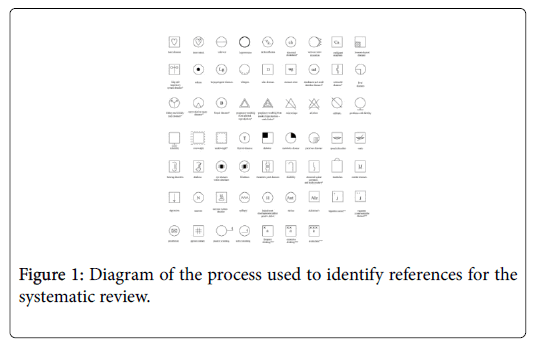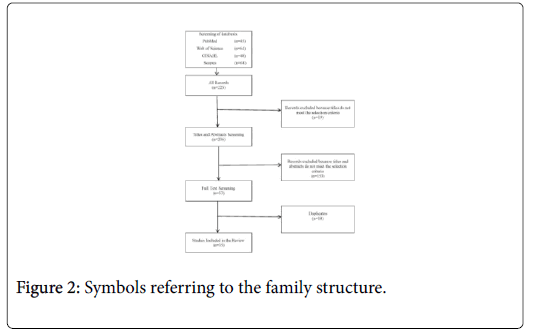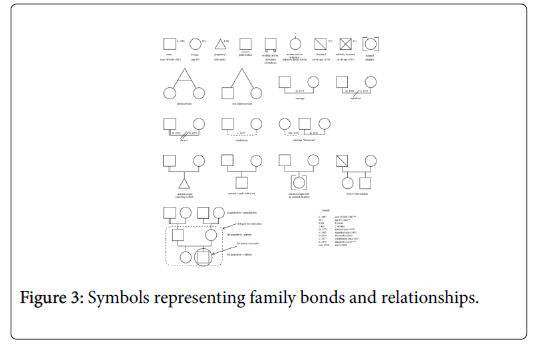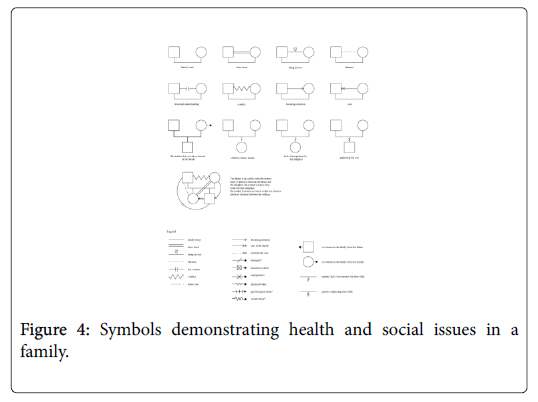Genograms in Nursing Education and Practice a Sensitive but Very Effective Technique: A Systematic Review
Received: 09-Dec-2018 / Accepted Date: 17-Dec-2018 / Published Date: 19-Dec-2018 DOI: 10.4172/2161-0711.1000640
Abstract
Introduction: A genogram resembles a genealogical tree, but it differs in that it takes into account family structure, ties and relationships, and also health and social problems in a family. The study presents the history of genograms and a general overview of symbols used for constructing them. Genograms have been used in nursing education and practice, mainly by family nurses, since 1980s. The study also discusses the rules of constructing a genogram, its advantages and possible weak points.
Objective: To present genograms as a valuable tool used for nursing instruction to be applied in working with families.
Material and Methods: A systematic review, analysis and summary of information found in the available literature with the authors' suggestions for supplementation. In May 2018 database searches were performed using the key word "genogram", including the PubMed, Web of Science, CINAHL and Scopus databases.
Results and Conclusions: Including the use of genograms in nursing education makes nurses' activities in the area of disease prevention and health promotion based on this tool the primary and least expensive form of healthcare. Genograms can be used as a research tool for all patients. It has a high research potential, facilitating nursing diagnosis and the choice of the optimum care procedure. However, software should be developed and disseminated to facilitate the creation and management of genograms.
Keywords: Family nursing; Education; Nursing; Symbolism; Family history; Family relations
Introduction
The history of genograms in healthcare services
The significance of family history information in the context of healthcare began to be appreciated by practitioners in the previous century [1-5]. Genograms were developed by Murray Bowen, a psychiatrist and family therapist, in 1950s and 1960s with the support of the Institute of Mental Health and the Georgetown Medical Center [6,7]. In 1966 Bowen established the symbols commonly applied for genograms [8]. In 1972 a genogram was defined as "a schematic diagram of the three-generational family relationship system” [9,10]. A number of attempts were made to standardize the symbols used for family diagrams in healthcare [2,11,12], and these endeavours were joined by family physicians and nurses [2,13-22]. Genograms were made popular in 1985 by psychologists Monica McGoldrick and Randy Gerson when their first book "Genograms in Family Assessment” was published as a practical guide on the application of genograms in clinical practice [14,23].
The graphic presentation of family relationships in nursing education dates back to the 1980s, when it began to be taught at the Department and Institute of Social Nursing of the Medical Academy in Lublin under the supervision of Professor Zofia Kawczyńska-Butrym. Its primary assumption was to serve community and family nursing practice [24]. The diagram is currently used in family nursing practice.
There are also genograms in the domain of culture, ethnic and racial identity and social classes [2,25,26], as well as spiritual and religious identity [25,26]. The use of genograms is becoming increasingly popular in many other fields such as genealogy, psychology and social work [2,14] and also various domains of business [14]. The diagram is also a recognised family therapy method for family physicians [14,27]. There are also specific genograms with a focus on breastfeeding [28], sex and sexuality [29,30], family history of breast and ovarian cancer [31], working with oncological patients undergoing chemotherapy [32,33] and hospice patients with families [33-35].
There is also the artistic genogram made solely of natural elements (leaves, flowers, chestnuts, cones, grass) used in psychotherapy [36]. Practitioners also recommend the use of genograms to paediatricians and primary healthcare nurses working in outpatient clinics [18,33,37], in their work with children and young people by using miniature symbols depicting the strong points and resources of the family [38], as well as to those working in schools [24,33,39].
Objective
The objective of the study was to present the genogram on the basis of the available literature, with the authors' suggestions for supplementation, as a valuable tool in nursing education to be used in work with families.
Material and Methods
The symbols used in the genogram was supplemented with partially modified and new self-designed symbols resulting from practical primary healthcare activities carried out for 10 years in an urban environment with nursing students as well as the analysis of scientific reports.
Search strategy
In May 2018 searches were performed on four electronic databases of publications, with 225 titles selected and 35 articles used. In addition, 8 books included in the literature list on the subject for nursing and psychology students in Poland were used along with 41 articles constituting sources for the aforementioned articles. After entering the key word "genogram” in article title without specifying the time period in the PubMed database, 45 articles were found, together with 64 articles in Web of Science, 48 in CINAHL and 68 in the Scopus database (starting from the year 2007). Several articles found in the mentioned databases overlapped. Figure 1 shows the flowchart of the study selection process.
The essence of the genogram
The genogram is a set of symbols constituting a graphic representation of diseases and relationships in a family [21,23,27,40]. It is based on the concept of the traditional genealogical tree, taking into account hereditary or behavioural patterns and psychological aspects of relationships [2,23,27]. Genograms have a considerable research potential [21]. It can be used as a screening test for all patients, with no exceptions [41]. The tool is dedicated to medical person and is designed to ensure optimum care [2,27,42-45], taking into consideration genetic and behavioural circumstances of the whole family, which are difficult to capture without a summary of the mentioned information. Genograms are therefore broadly used in family counseling as a tool for observing relationships and patterns transferred from generation to generation [2,21,27,42] and for explaining family problems [27,46]. Its flexibility makes it a perfect tool for planning a health education strategy covering disease prevention and health promotion [47].
Unfortunately, there is no available software enabling the creation of genograms which would make it possible to record information and archive it for research and treatment purposes. Although there are websites from which users can download a program for creating genograms, but their functionalities are limited. Therefore, it would be helpful to create electronic tools for nurses to manage family information in research and practice, with a necessity of maintaining communication and cooperation between nursing research theorists and nursing practitioners.
Description of basic symbols used to create a genogram
The review of the literature on the subject shows that there are 3 groups of symbols informing on the given family's structure, bonds and relationships as well as health and social problems.
Symbols referring to the family structure
They include 20 basic symbols depicting the family structure (Figure 2). Graphic symbols constituting a defined system for coding the family structure describe:
• The symbol of the man as a square placed on the right side and that of the woman as a circle on the left, the symbols of children from left to right in the sequence of their birth placed below their parents [9,21,27,48-51].
• At least three generations in a family [21,27,45,52-54] the first generation grandparents, the 2nd generation – parents, the 3rd generation–children [40]; including the siblings of all the people presented in the diagram.
• Year of birth of living individuals and age in years for deceased persons [9,27,45,46,55] placed outside the image [31] next to its upper right corner, which provides space for additional symbols inside. Age is also sometimes given for living persons [54,56,57]. In such case care should be taken to keep the notation uniform in the entire genogram (see Figure 2). However, in the analysis of historical genograms, providing year of birth for living individuals seems to be more practical and unambiguous.
• Living in the same place [24,40,58] related to the place of living and household expenses, marked with a dotted line.
• Person from the family for whom the genogram is created, marked with a circle [54,57].
Symbols representing family bonds and relationships
These are graphic symbols showing the nature of bonds and relationships in a family using a specific coding system (Figure 3). Based on the literature, 19 line symbols defining family bonds and relationships were identified. Three symbols were modified so as to prepare the graphic layout using one colour. The bonds and relationships component covers positive, neutral and negative aspects of family relationships.
Figure 3 shows 13 graphic arrangements as examples of possible configurations of symbols. The symbols are based on literature on the subject [24,27-61].
Symbols demonstrating health and social issues in a family
The third group of symbols represents individual diseases (if their incidence is high) or groups of diseases, disabilities and mental and social disorders (Figure 4). 61 graphic symbols are included in the group. Most of them are based on the available literature sources [24,40,45,55,60,62,63], part of which was modified.
The modifications were made as follows: lung diseases were changed to lung and respiratory system diseases, duodenum ulcer-to duodenum and small intestine diseases, gastrointestinal system diseases-to colorectal diseases, kidney diseases-to kidney and urinary tract diseases, female genital diseases-to reproductive organ diseases, abnormal spinal curvature to abnormal spinal curvature and faulty posture; furthermore, letter "a" was added to the alcohol addiction symbol.
Also, completely new symbols not used previously were added, such as abnormal cholesterol levels, breast diseases, pregnancy resulting from assisted reproduction, sex of an unborn child, underweight, disease carrier or communicable disease, and computer, narcotics, gambling medications, sex and television addictions. The advancement of addictions was presented by adding "x" symbols, with one "x" meaning frequent use, two "x"–excessive use and "3"-regular addiction.
The group is particularly important in family nursing practice because it enables an in-depth analysis of a given family's health and diseases and identifying social problems such as nicotine addiction, alcoholism or drug addiction. It also makes it possible to see genetic lines of certain diseases in a family in a three-generational arrangement.
Advantages of genograms in nursing practice
The graphic representation of a family is a tool which enables:
• Gaining more information than from a typical interview covering family structure, important life events, recurring diseases and family relationships [64,65].
• Reflecting a family's structure, i.e. the number of members and generations [24,41,66-70] Figure 2.
• A clear presentation of relationships in an entire family on one diagram [55], using several graphic symbols [57,60] Figure 3.
• A simple depiction of symbols [60] making up a family's genealogical tree [41];
• A time-saving synthetic presentation of information.
• Immediate identification of health risks [40,55].
• Making diagnoses related to biological disorders, family relationships, mental conditions and abuse of psychoactive substances and addictions in a family [2,3].
• Focusing on implementing the optimum educational procedure [40,55].
• Efficient flow of information in a therapeutic team [55].
• Ensuring privacy from outsiders not familiar with the meaning of the symbols [24,71].
• Obtaining an almost photographic view of the problems of the entire family at a specific time-the gradual evolution of the genogram into a chronogram [41].
The graphic diagram enables nurses working with families to:
• Present the life cycle of a family [66-70] e.g. the empty nest syndrome [2,72];
• Indicate important dates in family history [2,37,41,73];
• Show household members regardless of blood ties [24,40,45];
• Arrange information on diseases and causes of death for all family members [55,60]. Figure 4.
• Get insight into family problems allowing a better understanding of their behaviour and beliefs [45];
• Make family members aware of their health-related risks [60];
• Demonstrate the resources of a family which can be used to overcome particular difficulties [16,57,66-70], and also the weaknesses of the family [2];
• Build motivation among family members for future healthsupporting activities [60].
Disadvantages of genograms in nursing practice
Symbols used in genograms do not cover all diseases, social problems or relationships between people, which are highly diverse. Information related to the life situation of a family (living conditions, financial standing) [24], physical activity, diet, education, profession, nationality or religious denomination is not included in the symbols presented in the graphic diagram. The Rashomon effect is possible, where various family members view the same event from varying perspectives, providing different dates or descriptions of events [2]. The data are subject to distortions in the case of an insufficient theoretical preparation of a person making the genogram and the resulting improper interpretation [2]. Furthermore, there is a possibility that some information included in the genogram can be based more on the researcher's assumptions that on facts [2].
Despite their imperfections, genograms have a high research potential, facilitating nursing diagnoses in a whole family context, and enable the selection of a more detailed procedure for personalized care.
Discussion
The presented symbols of the graphic presentations of families, starting from their history and origin, rules of constructing them, and advantages and weak points, are an outcome of not only literature analysis but also teaching experience gained during classes with nursing students.
The use of genograms has gone through an evolution from psychiatrists and family physicians through psychologists to nurses. The genogram is an indispensable tool for nurses of any specialty in their work with the patient. An important benefit is a possibility of assessing the physical and psychosocial health of three generations, ensuring a comprehensive and holistic approach to the patient. Genograms streamline intervention planning, implementation and assessment in the care process and activities in the field of disease prevention and health promotion. This translates into reduces healthcare costs. The number of the available studies and articles shows the expanding range of genogram uses and, consequently, increases its value as a data collection tool.
Unfortunately, there is no available software enabling the creation of genograms which would make it possible to record information and archive it for research and treatment purposes.
Conclusions
Nursing education with the use of a genogram supports a holistic approach to patients and contributes to disease prevention and health promotion activities according to the principle that prevention is always better than cure. Genograms can be used as a research tool for all patients. Despite their imperfections, genograms have a high research potential, facilitating nursing diagnoses, and enable the selection of a more detailed procedure for personalized care. From the practice perspective, there are no electronic tools or computer software enabling the creation and management of genograms for research and treatment purposes.
References
- Zander LI (1977) Recording family and social history. J R Coll Gen Pract 27: 518-520.
- Papadopoulos L, Bor R, Stanion P (1997) Genograms in counselling practice: A review (part1). Counselling Psychol Quart 1: 17-28.
- Rogers J, Durkin M, Kelly K (1985) The family genogram: An underutilized clinical tool. N J Med 82: 887-892.
- Cormack JJ (1970) The medical record envelope--a case for reform. J R Coll Gen Pract 20: 333-353.
- Bowen M (1966) The use of family theory in clinical practice. Comprehensive Psychiat 7: 345-374.
- Curtis BJL (1984) The role of the family history in preventive medicine. Med Ref Serv Q 3: 35-44.
- Stagoll B, Lang M (1980) Climbing the family tree: Working with genograms. Aust J Fam Ther 1: 161-170.
- Butler JF (2008) The family diagram and genogram: Comparisons and contrasts. Am Fam Ther 36: 169-180.
- Guerin PJ, Fogarty TF (1972) Studying your own family in the book of family therapy, New York: Science House: 445-467.
- McGoldrick M, Gerson R (1985) Genograms in family assessment. New York.
- Jolly W, Froom J, Rosen MG (1980) The genogram. J Fam Pract 10: 251-255.
- Herth K (1989) The root of it all--genograms as a nursing assessment tool. J Gerontol Nurs 15: 32-37.
- Medalie JH (1978) Family medicine: Principles and applications. Williams & Wilkins Baltimore.
- Puskar K, Nerone MA (1996) Genogram: A useful tool for nurse practitioners. J Psychiatr Ment Health Nurs 3: 55-60.
- Rogers J, Durkin M (1984) The semi-structured genogram interview: 1 protocol, 2 evaluation. Family Systems Medicine 2: 176-187.
- McGoldrick M, Gerson R, Sueli P (2008) Genograms: Assessment and intervention. New York.
- Starkey PJ (1981) Genograms: A guide to understanding one’s own family system. Perspect Psychiatr Care 19: 165-173.
- Tobias A (2017) The use of genograms in educational psychology practice. Educ Psych Pract
- Oblacińska A, Ostręga W (2003) Standards and methodology of work of nurses and hygienists school. Guide for nurses and school hygienists working in various types of schools. IMiDz. Warszawa: 239-245.
- Goodman RD (2013) The transgenerational trauma and resilience genogram. Couns Psych Quart 26: 386-405.
- Thomas AJ (1998) Understanding culture and worldview in family systems. The Fam J 6: 24–32.
- Kehoe MP, Kehoe MP (2008) Using genograms creatively to promote healthy Lifestyles. J Creativ Men Health 2: 19-29.
- Darwent KL, Mclnnes RJ, Swanson VA (2016) The Infant feeding genogram: A tool for exploring family infant feeding history and identifying support needs. BMC Pregn Childbirth 16: 315-315.
- Belous ChK, Timm TM, Chee G, Whitehead MR (2012) Revisiting the sexual genogram. American J Fam Therapy 40: 281-296.
- Berman EM, Hof L (1986) The sexual genogram. J Marital Fam Ther 12: 39-47.
- Daly M, Farmer J, Harrop-Stein C, Montgomery S, Itzen M, et al. (1999) Exploring family relationships in cancer risk counseling using the genogram. Cancer Epidemiol Biomarkers Prev 8: 393–398.
- Glimelius B, Birgegard G, Hoffman K, Hagnebo G, Nordin K, et al. (1993) A comprehensive cancer care project to improve the overall situation of patients receiving intensive chemotherapy. J Psychosoc Oncol 11: 17-40.
- Wimbush FB, Peters RM (2000) Identification of cardiovascular risk: Use of a cardiovascular-specific genogram. Pub health nursing 17: 148-154.Â
- Liossi C, Hatira P, Mystakidou K (1997) The use of the genogram in palliative care. Palliat Med 11 : 455-461.
- Richards W, Burgess D, Petersen F, McCarthy D (1993) Genograms: A psychosocial assessment tool for hospice. Hos-pice J 9: 1-12.
- Mitrofan I, Petre L (2012) Art-genogram effects on dyadic relationship dynamic as a unifying transgenerational psychotherapy technique. Procedia-Social and Behavioral Sciences 78: 255-259
- Visscher EM, Clore ER (1992) The genogram: A strategy for assessment. J Pediatr Health Care 6: 361-367
- Taylor ER, Clement M, Ginger L (2013) Postmodern and alternative approaches in genogram use with children and adolescents. J Creativ Men Health 8: 278-292.
- Praeger SG, Martin LS (1994) Using genograms and ecomaps in schools. J Sch Nurs 10: 34-40.
- Turabian JL (2017) Family genogram in general medicine: A soft technology that can be strong. An Update. Res Med Eng Sci 1: 1-6.
- Gladding ST (2007) Family therapy: History, theory, and practice (4th edn.).
- Rogers LRJ, Like RC, McGoldrick M (1988) Reading and interpreting genograms: A systematic approach. J Fam Pract 26: 407-412.
- Rogers J, Rohrbaugm H, McGoldrick M (1992) Can experts predict health risk from family genograms? Fam Med 24: 209-215.
- Stanion P, Papadopoulos L, Bor R (1997) Genograms in counselling practice: Constructing a genogram (part 2). Couns Psych Quart 10 : 139-148.
- Hull GHJr, Mather J (2006) Understanding generalist practice with families. Belmont, CA: Thomson Brooks/Cole.
- Marinelli RD (1995) The genogram in health education. J Health Edu 26: 243-244.
- Bowen M (1980) The family life cycle: A framework for family therapy. New York: Gardner Press.
- Peace J, Lutz KF (2009) Nursing conceptualizations of research and practice. Nurs Outlook 57: 42-49.
- Titelman P (1998) Clinical applications of bowen family systems theory. New York: Haworth Press: 66–67.
- Hartman A (1978) Diagrammatic assessment of family relationships. Soc Case work 59: 465-476.
- Sen-Chowdhry S, Jacoby D, McKenna WJ (2012) A clinical approach to common cardiovascular disorders when there is a family history. Circ Cardiov Genet 5: 467-476.
- Zide MR, Gray SW (2000) The solutioning process: Merging the genogram and the solution-focused model of practice. J Fam Soc Work 4: 3-19
- Bennett RL, French KS, Resta RG, Doyle DL (2008) Standardized human pedigree nomenclature: Update and assessment of the recommendations of the national society of genetic counselors. J Genet Counsel 17: 424-433.
- Edwards J (2009) Application Review of genogram analytics, demo version. J Techno Human Ser 27: 235-240.
- Schilson E, Braun K, Hudson A (1993) Use of Genograms in family medicine: A family physician/family therapist collaboration. Fam Sys Med 11: 201-208.
- Kawczyńska-Butrym Z (1999) Nursing diagnosis. Lekarskie PZWL, Warsaw: 240-251.
- Friedman H, Rohrbaugh M, Krakauer S (1988) The time-line genogram: Highlighting temporal aspects of family relationships. Fam Proc 27: 293-303.
- Kawczyńska–Butrym Z (2001) Family- health-illness. Concepts and practice of family nursing. CZELEJ 68: 134-135.
- McGoldrick M, Gerson R, Shellenberger S (2007) Genograms: Diagnosis and intervention. Poznan.
- Crouch MA, Davis T (1987) Using the genogram (family tree) clinically. Fam Med Pract 174-192.
- Leahey M, Wright LM (1987) Families and psychosocial problems. Springhouse: 17-34.
- Rogers JC, Cohn P (1987) Impact of a screening family genogram on first encounters in primary care. Fam Pract 4: 291-301.
- Rogers J, Holloway R (1990) Completion rate and reliability of the self-administered Genogram. Fam Pract 2: 149-151
- Estrada AU, Haney P (1998) Genograms in a multicultural perspective. J Fam Psychother 9: 55-62.
- Marchetti-Mercer MC, Cleaver G (2000) Genograms and family sculpting: An aid to cross-cultural understanding in the training of psychology students in south africa. Couns Psychol 28: 61-80.
- Montiel BB, Fernández TJL (2012) A genogram "Ufff and Mmmm."AMF Joven 1: 3.
- Wachtel EF (1982) The family psyche over three generations: The genogram revisited. J Marital Fam Ther 8: 335-343.
- Watts C, Shrader E (1998) How to do (or not to do) the genogram: A new research tool to document patterns of decision-making, conflict and vulnerability within households. Health Policy Plan 13: 459-464.
- Butrym Z, Górajek-Jóźwik J, Kahlan J (1990) Nursing diagnosis. Materials for teachers. CMDNŚSZM, Warsaw.
- Rolland JS (1984) Toward a psychosocial typology of chronic and life threatening illness. Fam Syst Med 2: 245-262.
- DeMaria R, Weeks GR, Hof L (1999) Focused genograms: Intergenerational assessment of individuals, couples and families. Philadelphia, USA.
- Keskin Y (2017) The relational ethics genogram: An integration of genogram and relational ethics. J Fam Psychother 1: 92-98.
- Magnuson S (2000) The professional genogram: Enhancing professional identity and clarity. Fam J Alex Va 8: 399-401.
- Dobrossy L (1994) Prevention in primary care. Recommendations for promoting good practice. WHO.
Citation: Piasecka K, Slusarska B, Drop B (2018) Genograms in Nursing Education and Practice a Sensitive but Very Effective Technique: A Systematic Review. J Community Med Health Educ 8: 640. DOI: 10.4172/2161-0711.1000640
Copyright: © 2018 Piasecka K, et al. This is an open-access article distributed under the terms of the Creative Commons Attribution License, which permits unrestricted use, distribution, and reproduction in any medium, provided the original author and source are credited.
Share This Article
Recommended Journals
Open Access Journals
Article Tools
Article Usage
- Total views: 15531
- [From(publication date): 0-2018 - Apr 03, 2025]
- Breakdown by view type
- HTML page views: 14410
- PDF downloads: 1121




